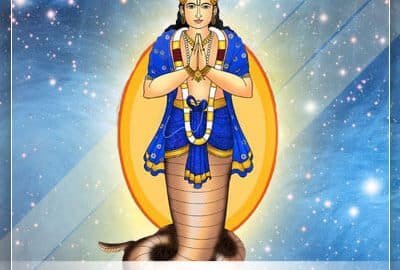Rahu, the lunar node on the northern side of the planet Moon (Chandra), is one of the nine planets in Hindu astrology called Navagrahas. Rahu’s chief deity is the goddess Durga. Rahu is only an imaginary point in the sky and is regarded as a shadowy planet. It has no physical existence. They are given the status of a planet because of their power. Rahu always moves in the opposite direction. Rahu completes the zodiac circle in 18 years because it takes him approximately 1.5 years to travel through each sign.
Rahu, according to Vedic astrology, is in charge of an individual’s ego, rage, mentality, lust, and alcoholism. Additionally, it governs numerous erroneous life activities. The unconscious desires, dissatisfactions, fears, obsessions, ambitions, illusions, hallucinations, trances, and unresolved issues from previous lives are frequently associated with Rahu.
Saturday is regarded as the ideal day for Rahu worship. Coconuts and black grams are presented to Rahu. Rahu is associated with the colors black and blue in Vedic astrology. Rahu’s gemstone is Gomedhagam (Hessonite).
According to numerous scriptures, Rahu only has a head and no torso or limbs. Rahu is sometimes depicted with four hands, his three hands holding a sword, a javelin, and a shield, and his fourth hand granting blessings. He is frequently depicted riding a dark lion.
When the amrita, the immortal potion, appeared during the Samudra manthan—the ocean’s churning—Devas and Asura fought, according to myth. In order to distribute the Amrita to the Devas and Asuras who assisted in the Manthan process, Lord Vishnu took on the role of Mohini, a dancer. Mohini kept Asuras in one line and Devas in the other for ease of distribution.
Swarbhanu, an Asura who posed as a deva, sat among the devas. Devas recognized Mohini’s amrita offering as a ruse and complained to Mohini, who then severed Swarnbhanu’s head with his Sudarshan Chakra. His body and head were immortalized because Swarnbhanu had already consumed the Amrita. Rahu is the name given to Swarnbhanu’s head, and Ketu is the name given to Swarnabhanu’s torso.
If Rahu is in a favorable position, the native will experience immense wealth and prosperity, according to Vedic astrology. Additionally, it grants authority, an administrative position, and exceptional diplomatic skills. Politics can also benefit from Rahu’s power. However, the natives’ susceptibility to deception and treachery can be increased by Rahu’s weak position. In their lives and careers, they would have to overcome many obstacles. People influenced by Rahu are also more likely to be affected by illnesses, legal actions, and imprisonment.
As the God of serpents, Rahu is praised in the sacred text Rahu Kavacham. Regular chanting of the hymn, according to devotees, will bring prosperity, fame, health, and spiritual insight.
There are a number of Rahu-themed temples. The Rahu temples in Thirupaamboor and Thirunageswaram in Tamilnadu are the most significant. The important temples of Lord Srikalahasteeswara in Andhra Pradesh and Kukkuke Subramaniya in Karnataka are dedicated to providing remedies for Sarpa dosha, or problems related to the serpent.
Tirunageswaram Naganathar Temple, also known as Rahu Stalam, is a Hindu temple in Tirunageswaram, a village on the outskirts of Kumbakonam, a town in Tamil Nadu, India. It is dedicated to the deity Shiva. As one of the Navagraha Stalas temples associated with the nine planet elements, specifically Rahu, it is significant to the Hindu sect of Saivism. The lingam is a symbol of Shiva, who is worshiped as Naganathar. Piraisoodi Amman is portrayed as his wife Parvati. In the Tamil Saiva canonical work Tevaram, which was written by Tamil saint poets known as the nayanars and is categorized as Paadal Petra Sthalam, the presiding deity is praised.
Thirunageswaram is one of the many temple towns in the state. It gets its name from the grooves, clusters, or forests that are dominated by one kind of tree or shrub and where the presiding deity is housed by the same kind of tree or shrub. The area is known as Chamapakavanam because it is believed to have been covered in Chamapaka forest.
At this location, many serpents, including Adishesha, Takshaka, and Karkotaka, adored Shiva and gave it the name “Tirunageswaram.” According to Hindu legend, Adisesha, the king of snakes, performed penance at this location, which is known as Senbaranya Kshetram due to the abundance of Senbaga trees there. Shiva appeared to him because he was pleased with the penance. Naganathar is the name given to the Serpent king because Shiva granted him a blessing. Here, along with the goddesses Lakshmi, Saraswathi, Ganesha, Muruga, and Shasta, it is believed that a Goddess called Girigujambal is offering worship to Shiva. It is still believed that Maha Bhairava watches over the divine mother and helps her pray. Because she is present in the form of Meru, it is believed that the Goddess is Swayambu. As a result, no ablution of the image is carried out. According to a Hindu legend, the sage Gautama cursed Indra for being unruly with Gautama’s wife, Ahalya. It is said that Indra worshipped Giri-Gujambigai for 45 days with a scented substance called Punugu in order to break the sage’s curse. At this location, Naganathar is said to have been worshiped by sages like Gautama and Parashara as well as kings like Bhagiratha and Nala.

